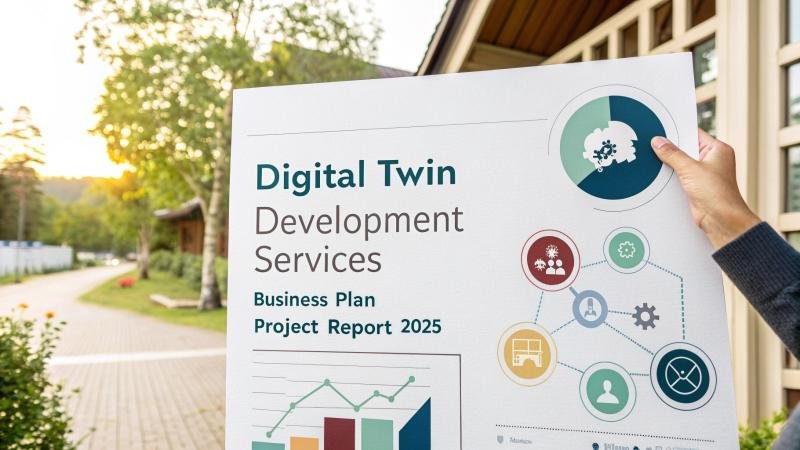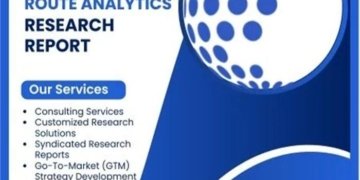Digital Twin Development Services Business Plan & Project Report Overview
IMARC Group’s “Digital Twin Development Services Business Plan and Project Report 2025” offers a comprehensive framework for establishing a successful digital twin development services business. The critical areas, including market trends, investment opportunities, revenue models, and financial forecasts, are discussed in this in-depth report and are therefore useful resources to entrepreneurs, consultants and investors. Whether evaluating the viability of a new venture or streamlining an existing one, the report gives an in-depth analysis of all the ingredients that make it successful, starting with business formation and profitability over time.
What is a Digital Twin Development Services Business?
A Digital Twin Development Services business is a specialized technology organization designed to deliver comprehensive, simulation-driven solutions for virtual asset representation and optimization. These businesses emphasize advanced modeling using real-time data integration, 3D visualization, predictive analytics, IoT sensor connectivity, artificial intelligence algorithms, and physics-based simulation engines, catering to manufacturing companies, smart cities, healthcare facilities, energy sectors, and enterprises seeking virtual replicas of physical assets for performance optimization.
They offer a variety of services including digital twin architecture design, sensor integration planning, real-time monitoring dashboards, predictive maintenance solutions, process optimization modeling, asset lifecycle management, simulation-based testing, scenario analysis tools, and continuous performance analytics for organizations committed to digital transformation and operational excellence.
The category encompasses industrial digital twin specialists, smart manufacturing consultants, infrastructure modeling firms, and virtual simulation providers, each prioritizing accurate data synchronization, high-fidelity modeling, real-time analytics processing, predictive algorithm development, cross-platform integration, scalability planning, industry-specific customization, and strategic operational intelligence delivery.
To achieve these goals, Digital Twin Development Services businesses integrate state-of-the-art 3D modeling software, IoT integration platforms, cloud computing infrastructure, artificial intelligence and machine learning engines, simulation software, data analytics tools, augmented and virtual reality systems, and digital twin-specific development frameworks.
Depending on their positioning, these establishments may operate as specialized industrial IoT digital twin developers, smart city virtual modeling consultancies, asset performance management specialists, or comprehensive digital transformation centers, delivering complete virtual replication services tailored to diverse industry sectors, operational complexities, and levels of digital maturity.
Request for a Sample Report: https://www.imarcgroup.com/digital-twin-development-services-business-plan-project-report/requestsample
Digital Twin Development Services Business Market Trends and Growth Drivers
The trends and drivers of a Digital Twin Development Services business are shaped by the accelerating adoption of Industry 4.0 technologies across manufacturing sectors, growing emphasis on predictive maintenance to reduce operational downtime, and the increasing need for remote monitoring and simulation capabilities. These factors, combined with a stronger focus on asset optimization, energy efficiency, and data-driven decision making, are fuelling demand for sophisticated digital twin solutions. Contributing to this shift is the expanding interest in smart cities, connected infrastructure, digital healthcare systems, and autonomous operations, along with enterprise preferences for virtual commissioning, risk-free testing environments, and convenient access to real-time operational insights within the evolving industrial digitalization ecosystem.
To meet these demands, operators are investing in advanced simulation platforms, high-performance computing infrastructure, IoT connectivity solutions, AI-powered analytics capabilities, and compliance with industry standards such as ISO 23247 and data security protocols. These investments not only enhance the digital twin development capabilities but also strengthen business outcomes by aligning with broader trends in digital transformation and predictive intelligence.
Revenue diversification is another critical factor in building financial resilience. In addition to direct digital twin development services, income streams may include software-as-a-service subscriptions, ongoing maintenance and support contracts, data analytics consulting, training and enablement programs, custom integration services, simulation-as-a-service offerings, strategic advisory packages, and licensing arrangements.
Location and ecosystem partnerships play a vital role in success. Businesses positioned in regions with high concentrations of manufacturing facilities, technology innovation hubs, research institutions, and access to skilled data scientists and 3D modeling experts benefit from steady client acquisition and industry credibility. At the same time, robust development infrastructure, compliance with data protection regulations, and adherence to industry-specific modeling standards ensure operational excellence and client trust.
However, the business also faces risk factors, such as rapidly evolving technology platforms that require continuous skill development, intense competition from established technology consulting firms and emerging digital twin startups, dependence on high-quality sensor data and system interoperability, and cybersecurity concerns related to connected systems and real-time data transmission.
A successful Digital Twin Development Services business model requires careful financial planning-including capital investment in computing infrastructure and development environments, procurement of specialized software licenses and simulation tools, and adoption of cutting-edge AI, IoT, and visualization technologies. It also demands skilled digital twin architects and domain experts, supported by effective marketing strategies to build brand awareness, foster loyalty, and establish long-term relationships with manufacturing enterprises, infrastructure operators, and industry consortiums. By delivering high-quality virtual models, innovative predictive solutions, and exceptional client support, these businesses can strengthen operational efficiency while encouraging clients to embrace digital-first asset management and continuous optimization strategies.
Report Coverage
The Digital Twin Development Services Business Plan and Project Report includes the following areas of focus:
• Business Model & Operations Plan
• Technical Feasibility
• Financial Feasibility
• Market Analysis
• Marketing & Sales Strategy
• Risk Assessment & Mitigation
• Licensing & Certification Requirements
The comprehensive nature of this report ensures that all aspects of the business are covered, from market trends and risk mitigation to regulatory requirements and digital-twin-focused client acquisition strategies.
Key Elements of Digital Twin Development Services Business Setup
Business Model & Operations Plan
A solid business model is crucial to a successful venture. The report covers:
• Service Overview: A breakdown of digital twin architecture design, 3D modeling services, IoT sensor integration, real-time data synchronization, predictive analytics development, simulation testing, virtual commissioning, and performance optimization services offered
• Service Workflow: How each client engagement, requirements analysis, data integration, model development, validation testing, deployment, and client feedback process is managed
• Revenue Model: An exploration of the mechanisms driving revenue across multiple digital twin services and consulting offerings
• SOPs & Service Standards: Guidelines for consistent modeling quality, data accuracy protocols, simulation standards, and client digital twin satisfaction
This section ensures that all operational and client service aspects are clearly defined, making it easier to scale and maintain development quality.
Buy Report Now: https://www.imarcgroup.com/checkout?id=43345&method=1911
Technical Feasibility
Setting up a successful business requires proper technology infrastructure and development planning. The report includes:
• Location Selection Criteria: Key factors to consider when choosing business locations and target digital twin markets
• Space & Costs: Estimations for required office space, development laboratories, high-performance computing facilities, and associated costs
• Equipment & Systems: Identifying essential 3D modeling workstations, simulation software, IoT integration platforms, and visualization technology
• Development & Testing Setup: Guidelines for creating advanced digital twin development facilities and virtual testing environments
• Utility Requirements & Costs: Understanding the computing power, cloud infrastructure, and utilities necessary to run digital twin development operations
• Human Resources & Wages: Estimating staffing needs, roles, and compensation for digital twin architects, 3D modelers, data scientists, IoT specialists, and support personnel
This section provides practical, actionable insights into the technology infrastructure and expertise needed for setting up your business, ensuring development excellence and modeling accuracy.
Financial Feasibility
The Digital Twin Development Services Business Plan and Project Report provides a detailed analysis of the financial landscape, including:
• Capital Investments & Operating Costs: Breakdown of initial and ongoing investments
• Revenue & Expenditure Projections: Projected income and cost estimates for the first five years
• Profit & Loss Analysis: A clear picture of expected financial outcomes
• Taxation & Depreciation: Understanding tax obligations and equipment depreciation
• ROI, NPV & Sensitivity Analysis: Comprehensive financial evaluations to assess profitability
This in-depth financial analysis supports effective decision-making and helps secure funding, making it an essential tool for evaluating the business’s potential.
Market Insights & Strategy
Market Analysis
A deep dive into the digital twin development services market, including:
• Industry Trends & Segmentation: Identifying emerging trends and key market segments across industrial manufacturing twins, smart city infrastructure, healthcare digital twins, energy sector modeling, automotive simulation, and aerospace virtual testing
• Regional Demand & Cost Structure: Regional variations in digital transformation adoption and cost factors affecting development operations
• Competitive Landscape: An analysis of the competitive environment including established technology consulting firms, specialized digital twin developers, industrial software vendors, and systems integrators
Profiles of Key Players
The report provides detailed profiles of leading players in the industry, offering a valuable benchmark for new businesses. It highlights their strategies, service offerings, technology platforms, and market positioning, helping you identify strategic opportunities and areas for differentiation.
Capital & Operational Expenditure Breakdown
The report includes a comprehensive breakdown of both capital and operational costs, helping you plan for financial success. The detailed estimates for infrastructure development, technology acquisition, and operating costs ensure you’re well-prepared for both initial investments and ongoing expenses.
• Capital Expenditure (CapEx): Focused on office space setup and design, high-performance computing infrastructure, 3D modeling workstations, simulation software licenses, IoT integration platforms, visualization systems, and development environment tools
• Operational Expenditure (OpEx): Covers ongoing costs like staff salaries, software subscription fees, cloud computing costs, utilities, marketing expenses, training and certification fees, research and development, and infrastructure maintenance
Financial projections ensure you’re prepared for cost fluctuations, including adjustments for technology upgrades, software licensing renewals, talent acquisition costs, and competitive market pressures over time.
Profitability Projections
The report outlines a detailed profitability analysis over the first five years of operations, including projections for:
• Total revenue from development services, consulting engagements, and subscription offerings, expenditure breakdown, gross profit, and net profit
• Profit margins for each revenue stream and year of operation
• Revenue per client projections and market penetration growth estimates
These projections offer a clear picture of the expected financial performance and profitability of the business, allowing for better planning and informed decision-making.
Request For Customization: https://www.imarcgroup.com/request?type=report&id=43345&flag=E
Our expertise includes:
• Market Entry and Expansion Strategy
• Feasibility Studies and Business Planning
• Company Incorporation and Digital Twin Development Setup Support
• Regulatory and Licensing Navigation
• Competitive Analysis and Benchmarking
• Industry Partnership Development
• Branding, Marketing, and Digital-Twin-Focused Client Strategy
About Us
IMARC Group is a leading global market research and management consulting firm. We specialize in helping organizations identify opportunities, mitigate risks, and create impactful business strategies.
Contact Us:
IMARC Group
134 N 4th St. Brooklyn, NY 11249, USA
Email: sales@imarcgroup.com
Tel No:(D) +91 120 433 0800
United States: (+1-201971-6302)
This release was published on openPR.













